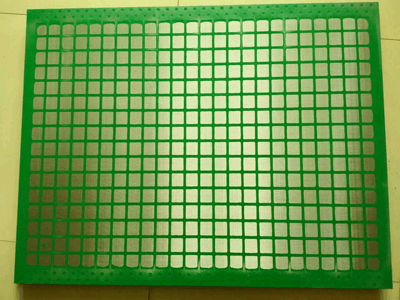Actually, there were few solids control equipment manufacturer producing shaker screens. Shaker screens are mainly…
2018

Size Of Solids And Screen
Size of solids in a mud can be anything from the largest chunk that can be pumped up the annulus to clay platelets and chemical precipitates, both so small that an electron-beam microscope is needed to see them. The API has designated size ranges for particulate material in drilling muds. Sand is defined as particles larger than 74 microns (200 mesh). Particles in the 2 to 74 micron range are called silt. API barite and API hematite have size specifications set by API Spec. 13A (see table 1).

| Table 1. Familiar Size Comparisons | |
| Particles | Microns |
| Fingers can feel “grit” | 20 |
| Talcum powder | 5-50 |
| Human hair (finest size) | 30-200 |
| Dust particles seen in air | approx 7 |
| Colloids in muds | <2 |
| API Silt | 2 – 74 |
| API Sand | >74 |
| API Barite Specifications | |
| Max. 3% larger than | 74 |
| Max. 30% smaller than | 6 |
| Dispersed bentonite | <2 |
The following dimensions are used to define sizes of solids in muds:
- ÄNGSTROM is the dimension used for molecular diameters and clay thickness. Smectite clay crystals are 14 Å thick. Kaolinites are 7 Å thick. There are 10,000 Å in one micron.
- MICRON is a dimension used to describe very small particles. One micron is equivalent to 0.0000393 in. There are 25,400 microns in 1 in.
- STANDARD SIEVE SIZES (shown in Table 2) give micron sizes for standard square-mesh sieves. Table 3 shows standard market-grade screen cloths and corresponding opening sizes. Total screen cloth open area will vary with wire size.
| Table 2. Standard Sieve Sizes | |
| U. S. Test (Sieve No.) | Opening Size (Microns) |
| 20 | 841 |
| 30 | 595 |
| 40 | 410 |
| 50 | 297 |
| 60 | 250 |
| 80 | 177 |
| 100 | 149 |
| 120 | 125 |
| 140 | 105 |
| 170 | 88 |
| 200 | 74 |
| 325 | 44 |
| Table 3. Standard Market-Grade Shaker Screen Cloths | |
| Shaker Screen Size | Opening Size (Microns) |
| 8 x 8 | 2464 |
| 10 x 10 | 1905 |
| 20 x 20 | 864 |
| 40 x 40 | 381 |
| 80 x 80 | 178 |
| 100 x 100 | 140 |
| 120 x 120 | 117 |
| 200 x 200 | 74 |
| 325 x 325 | 44 |
Shape of Solids
A distribution of particle shapes and sizes is needed to form a good filter cake. It is difficult to know what shapes and sizes are needed for each situation or what size distribution and particle shapes actually exist in a mud. Tests and analyses such as: the Permeability Plugging test, HTHP Static Filtration test, particle size measurements and microscope studies, can help define particle sizes and shapes. It is known that some of the particles should be deformable and flat, like bentonite, to build a low-permeability filter cake.
